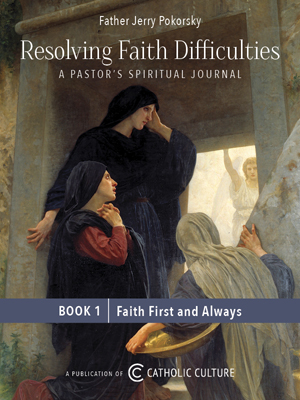Vatican II on the Liturgy: Particular Norms & the Eucharist
By Dr. Jeff Mirus ( bio - articles - email ) | Feb 11, 2010 | In On the Documents of Vatican II
Following the General Norms, the Constitution on the Sacred Liturgy outlines more particular norms for authentic renewal which clarify more precisely what the Council Fathers intend. In the “Norms Drawn from the Hierarchic and Communal Nature of the Liturgy”, the Council emphasizes that liturgical services are not private functions but “celebrations of the Church which is ‘the sacrament of unity,’ namely, ‘the holy people united and arranged under their bishops’” (26).
Therefore, liturgical services “pertain to the whole Body of the Church. They manifest it, and have effects upon it. But they also touch individual members of the Church in different ways” (26). The text specifies that “each person, minister or layman, who has an office to perform, should carry out all and only those parts which pertain to his office by the nature of the rite and the norms of the liturgy” (28). And to promote active participation, “the people should be encouraged to take part by means of acclamations, responses, psalms, antiphons, hymns, as well as by actions, gestures and bodily attitudes. And at the proper time a reverent silence should be observed” (30).
In the “Norms Based upon the Educative and Pastoral Nature of the Liturgy”, we find that “the rites should be distinguished by a noble simplicity. They should be short, clear, and free from useless repetitions. They should be within the people’s powers of comprehension, and normally should not require much explanation” (34). In context, this may legitimately be taken as a call to purify the Tridentine rite of some of its repetition and obscurity. It is undeniable that the structure of the Novus Ordo is easier to follow and the relationship among the parts clearer. Many would argue, however, that liturgists have shown so little respect for the intelligence of non-professionals that they have introduced triviality and banality as a substitute for “noble simplicity”.
In this section also belongs the norm for the use of both Latin and the vernacular. Essentially, “the use of the Latin language…is to be preserved in the Latin rites” but because the use of the vernacular in Mass and the sacraments “may frequently be of great advantage to the people, a wider use may be made of it, especially in readings, directives and in some prayers and chants” (36).
The second Chapter, on the Eucharist, provides the quotations which most closely enshrine what the Council hoped to achieve with respect to the Mass. Two sections are worth quoting at particular length:
The Church, therefore, earnestly desires that Christ’s faithful, when present at this mystery of faith, should not be there as strangers or silent spectators. On the contrary, through a good understanding of the rites and prayers they should take part in the sacred action, conscious of what they are doing, with devotion and full collaboration. They should be instructed by God’s word, and be nourished at the table of the Lord’s Body. They should give thanks to God. Offering the immaculate victim, not only through the hands of the priest but also together with him, they should learn to offer themselves. Through Christ, the Mediator, they should be drawn day by day into ever more perfect union with God and each other, so that finally God may be all in all. (48)
And, therefore:
For this purpose the rites are to be simplified, due care being taken to preserve their substance. Parts which with the passage of time came to be duplicated, or were added with little advantage, are to be omitted. Other parts which suffered loss through accidents of history are to be restored to the vigor they had in the days of the holy Fathers, as may seem useful or necessary. (50)
In this section again, the Council calls for the purposes and relationships of the parts of the Mass to be made clear; for the homily to further honor the Word of God by drawing its inspiration from the readings of the day; for the restoration of the prayer of the faithful; for increased use of the vernacular; for the use of hosts at Communion which were consecrated at the same Mass (this was commonly not the practice before the Council); for the faithful to understand that they should attend the whole Mass (both the liturgy of the Word and of the Eucharist, as many inthose days short-changed everything before the Offertory and after Communion); and for proper procedures for concelebration.
It is perfectly consistent with the Council’s understanding of the importance of the Liturgy to the Church’s life that this second chapter on the Eucharist should complement the first in articulating most clearly the Council’s desires and goals. It remains in my final commentary on the Constitution on the Sacred Liturgy to look briefly at matters of concern apart from the Mass itself.
Previous in series: Vatican II on the Liturgy: Overview & General Norms
Next in series: Vatican II on the Liturgy: Related Concerns
All comments are moderated. To lighten our editing burden, only current donors are allowed to Sound Off. If you are a current donor, log in to see the comment form; otherwise please support our work, and Sound Off!
-
Posted by: Jeff Mirus -
Feb. 13, 2010 2:28 PM ET USA
The documents of ecumenical councils are not proposed to the Church as matters for debate. For these summaries of the documents of Vatican II, we are not accepting Sound Off! posts which criticize what the Council said. Any magisterial document could be criticized for not saying what someone wished; this is hardly the point. However, comments on any deficiencies in my summaries are most welcome here, while strategies for how to proceed in the future are best discussed later.








